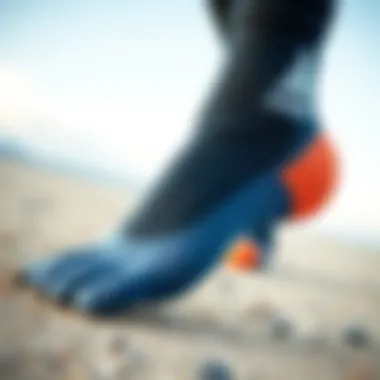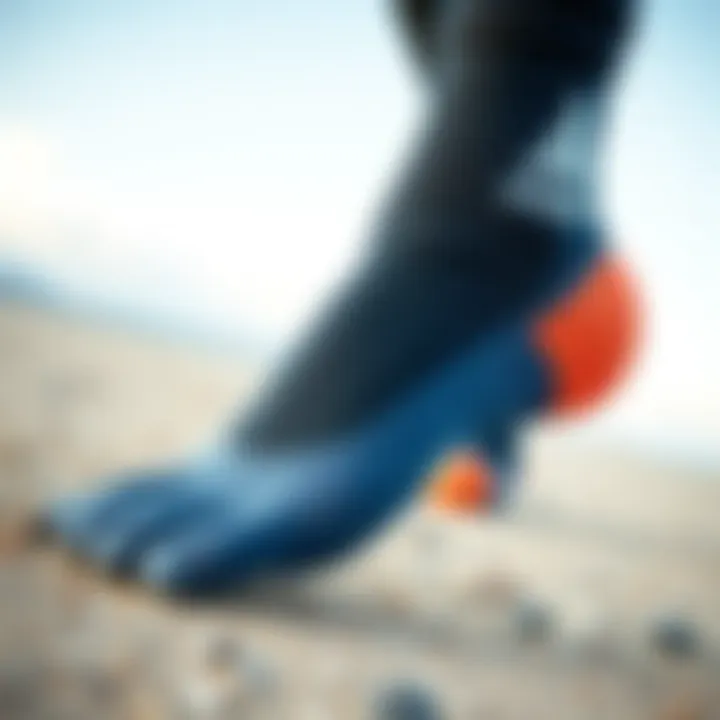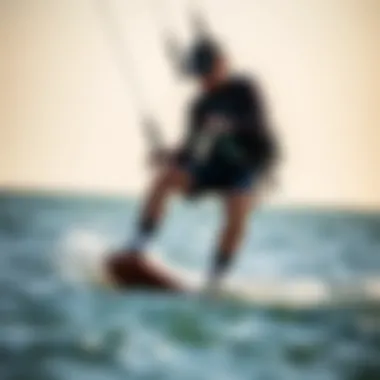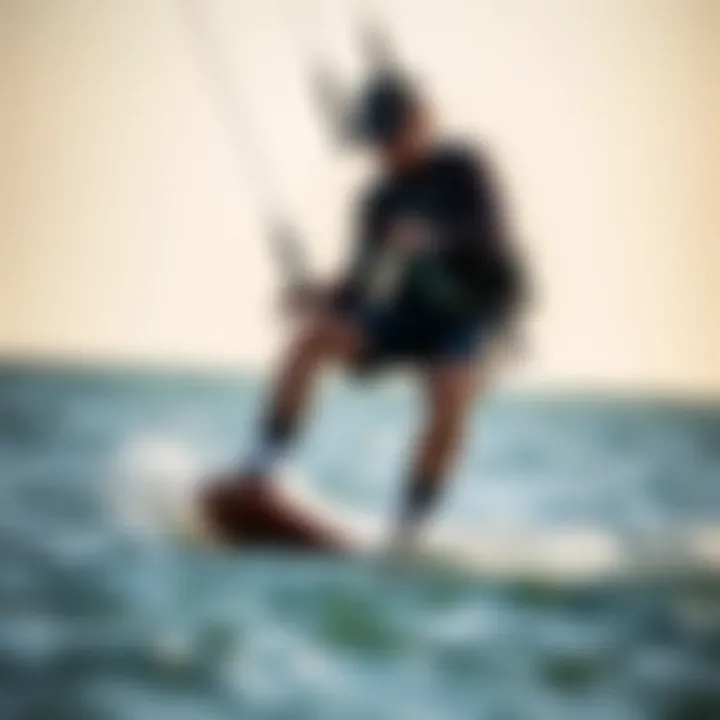A Comprehensive Guide to Split Toe Neoprene Socks


Intro
When it comes to kiteboarding, every little bit of gear can make a significant difference. One often-overlooked piece of equipment is the split toe neoprene sock. These specialized socks can enhance your experience on the water, providing comfort, warmth, and a better grip on your board. In this guide, we’ll dig into the details of these socks – from their design and the advantages they offer to how to select the perfect pair.
The world of kiteboarding is filled with numerous gear options, so choosing the right ensemble might feel daunting, especially when it comes to your feet. You’ll want socks that not only keep you warm but also provide that essential connection between you and your board. This article is here to cut through the noise and offer a focused discussion on split toe neoprene socks, ensuring you're well-equipped for your next adventure.
Let’s take a closer look at how to select the right gear for kiteboarding, including the benefits of split toe neoprene socks. After all, understanding these details can elevate your riding experience.
Gear Selection
When gearing up for kiteboarding, it’s essential to make informed decisions about what to wear, especially when it comes to your feet. Split toe neoprene socks may be a game-changer, but they are just one piece of the puzzle. The following sections delve into various aspects of kiteboarding gear selection to ensure an optimal experience.
Types of Kites
Choosing the right kite is pivotal in determining your performance and enjoyment in kiteboarding. Kites vary in size, shape, and function. Some key types include:
- C-Kites: Perfect for experienced riders seeking high performance and power.
- Bow Kites: Known for their depower ability, suitable for beginners and intermediate kiteboarders.
- Delta kites: Providing a balance between performance and ease of use, adaptable for multiple skill levels.
Each kite has unique characteristics that suit different wind conditions and rider preferences, making it crucial to select the right type based on your skills and experience.
Choosing the Right Board
The board you ride on can drastically affect your overall kiteboarding experience. When selecting a board, consider:
- Board Size: A larger board offers more stability, ideal for beginners. A smaller board, on the other hand, provides more maneuverability.
- Shape and Rocker: Boards come with various shapes to cater to different riding styles. A board with more rocker helps in choppy waters, while a flatter board is great for speed.
- Flexibility: The way a board flexes impacts your ride. A stiffer board is better for high-speed riding, while a softer board can absorb shocks better.
Finding the perfect board can greatly enhance your ability to harness the wind and give you a sense of control as you ride across the waves.
Choosing the right gear – from your kite to your board and socks – is as important as mastering techniques. Each component contributes to your overall on-water experience.
While the above gear is essentials, outfitting your feet with the right split toe neoprene socks can lead to a significant upgrade in your overall comfort and performance. With a firm understanding of your gear choices, you’re on your way to a thrilling kiteboarding experience.
Understanding Split Toe Neoprene Socks
Split toe neoprene socks have gained traction among kiteboarders for a multitude of reasons, warranting a closer look at their significance in the world of water sports. These specialized socks serve a unique purpose, marrying functionality with comfort in a way traditional socks simply can't. By understanding the mechanics behind their design and the materials that compose them, kiteboarding enthusiasts can make informed decisions about their gear, ultimately enhancing their experience on the water.
Defining Split Toe Design
The split toe design is a distinguishing characteristic of these neoprene socks, allowing for greater toe dexterity while still providing a snug fit. Rather than having a single compartment for all toes, perforation between the big toe and the rest enhances balance. When kiteboarding, having your toes spread out can significantly improve grip on your board, giving you a better feel for the ride.
With a design reminiscent of traditional surfing booties, the split toe style is often preferred by those who value a connection with their equipment. Picture a pianist whose fingers glide over the keys; that’s how split toe socks allow kitesurfers to maneuver their boards with precision.
In practical terms, this means that as you cut through the water, your feet react more naturally to the board's movements. This responsiveness can be the difference between a smooth ride and a precarious one, particularly when dealing with waves or strong winds. It’s not just about style; it’s about enhancing performance.
Material Composition: Why Neoprene?
Neoprene is the favored material for split toe socks for several reasons that cater specifically to the needs of kiteboarders. First and foremost, it offers excellent insulation. Water can be quite chilling, especially in cooler climates, and neoprene effectively retains body heat, keeping your feet warm throughout your session.
Moreover, neoprene is notably flexible, allowing for unrestricted movement. When you're out on the waves, the last thing you want is a restrictive fit that can impair your agility. The elasticity of neoprene also contributes to its durability, meaning that a well-made pair of neoprene socks can withstand the rough and tumble of kiteboarding environments.
Additionally, neoprene's water-resistant properties help keep your feet dry and prevent irritation from sand or debris. This is essential for kiteboarders who spend hours on the water. With the right pair of split toe neoprene socks, you're essentially setting your feet up to thrive in both performance and comfort.
"Choosing the right material can make or break your kiteboarding experience, and neoprene stands out as the material of choice for many, thanks to its blend of comfort, warmth, and flexibility."
As you delve deeper into the unique features of split toe neoprene socks, it becomes evident that understanding these essentials is crucial for kiteboarders of all skill levels, from novices learning the ropes to seasoned pros aiming to maximize their performance.
Advantages of Using Split Toe Neoprene Socks


When it comes to kiteboarding, every detail can make a significant difference in performance and comfort. Split toe neoprene socks have carved a niche for themselves among kiteboarders, thanks to their unique design and practical benefits. Let’s take a closer look at some notable advantages that make these socks a wise choice for enthusiasts navigating the waters.
Enhanced Flexibility and Comfort
One of the most prominent benefits of split toe neoprene socks is the enhanced flexibility they offer. The split design allows for greater toe articulation, which is something traditional socks simply can’t match. This means a kiteboarder can maneuver their feet more effortlessly in the footstraps, maintaining a natural feel on the board.
Comfort is also a major factor. The neoprene material hugs the feet snugly without being overly constrictive, which can be a game changer during long rides. On chilly days, having an extra layer without sacrificing movement is critical to enjoyment and safety. Kiteboarders often rave about how the socks feel like a second skin, helping them stay focused on their performance rather than discomfort.
Improved Board Control
Improved board control is another compelling reason to opt for split toe neoprene socks. With toes separated, riders gain more tactile feedback from their board, allowing them to respond quicker to shifts in balance and position. This direct connection enhances control, particularly when navigating rough waters or performing tricks.
Furthermore, the way these socks fit into the footstraps leads to fewer slip-ups. When your toes grip their own space, you can adjust your weight distribution more effectively, lending itself to better stability during jumps or quick maneuvers. This added precision can set an experienced kiteboarder apart from the rest, as even the smallest edge in control can result in an impressive riding performance.
Thermal Insulation Benefits
Thermal insulation is paramount for kiteboarders venturing into cooler waters. Split toe neoprene socks provide a blanket of warmth, making rides during off-peak seasons far more enjoyable. The thickness of neoprene acts as an insulator, keeping feet cozy while still being lightweight enough to maintain agility.
Riders often underestimate the impact cold feet can have on overall performance. When your toes are warm, you're able to concentrate better on your skills rather than the chill creeping in. Additionally, having warm feet boosts circulation, ensuring you're not only comfortable but also safe against potential cramps during long sessions.
Staying warm while engaging in kiteboarding can enhance focus and prolong your time on the water.
Potential Drawbacks of Split Toe Neoprene Socks
While split toe neoprene socks have their fair share of advantages, it's equally essential to recognize the potential drawbacks that come along with them. Understanding these considerations can help kiteboarders make informed decisions as they explore their options. Selecting the right gear is pivotal not just for comfort and performance but also for avoiding any unpleasant surprises. In this section, we will delve into some common concerns that kiteboarders might encounter when opting for split toe socks.
Issues with Sizing and Fit
Getting the right fit with split toe neoprene socks can be a bit tricky. Unlike traditional socks that provide a simple covering, these specialized designs demand a more precise sizing approach. Kiteboarders may face complications in achieving a snug yet comfortable feel. Factors like the width of one’s foot, the length of the toes, and the overall shape can play a role in determining the ideal size.
For instance, a person with wider feet might find that the split toe causes discomfort, as it may pinch or not conform well to their foot shape. Additionally, if the socks are too loose, they can cause bunching, impacting board control and comfort on the water. It’s imperative to try these socks on, if possible, or check the brand's sizing chart carefully before making a purchase. The difference between a great day on the water and a frustrating session can come down to how well your socks fit.
Durability Concerns
Another key drawback of split toe neoprene socks is related to their durability. While neoprene itself is known for its resilience, nuanced designs like the split toe can introduce weak points. The separation of the toes may weaken the structure, especially during intense kiteboarding activities. Over time, wear and tear can lead to more rapid degradation than traditional socks.
Moreover, there’s the issue of exposure to saltwater and UV rays, which can wear down the material's integrity. Long-term exposure can cause the neoprene to lose elasticity, which directly affects the performance of the socks.
- Regular inspection for signs of cracking or thinning is critical.
- Considerations for cleaning are also essential; proper washing can extend their life significantly, while neglecting maintenance can lead to quick declines in durability.
"Choose wisely when it comes to your gear; sometimes, what seems beneficial may come with challenges."
In short, while split toe neoprene socks bring flexibility and control to the table, they present challenges in sizing and a potential reduction in durability that kiteboarders should keep in mind. By addressing these aspects, enthusiasts can better evaluate their gear and perhaps find a balance that maximizes performance while minimizing drawbacks.
Selecting the Right Split Toe Neoprene Socks
Choosing the appropriate split toe neoprene socks can feel like finding a needle in a haystack, especially with many options available on the market. A well-selected pair not only enhances your kiteboarding experience but also keeps your feet warm and protected from the elements. Kiteboarding often requires specific gear, and socks are perhaps one of the most underrated elements.
When selecting your pair, consider their thickness and warmth. Also, the fit is equally important. An ill-fitting sock can lead to discomfort, blisters, or even lack of control over your board. Thus, it’s prudent to angle your approach towards these aspects to ensure you have an enjoyable ride without any needless distractions or worries.
Evaluating Thickness and Warmth
Thickness usually goes hand-in-hand with warmth, but it doesn't always equate to comfort. If you're riding in mild weather, a thinner sock might suffice, providing adequate warmth while still allowing for flexibility and board feel. However, in colder conditions, opting for thicker socks becomes necessary. Just remember, while thickness adds warmth, it can also reduce sensitivity—something kiteboarders heavily rely on for steering and stability.
Among the thick options available, there are 3mm to 5mm neoprene socks that aim to keep your feet toasty in freezing waters. A 3mm sock might offer a balance between warmth and control, allowing you that tad bit more responsiveness when needed.
Some considerations when choosing thickness:


- Water Temperature: The colder the water, the thicker the sock.
- Personal Sensitivity: Some people get cold easier than others, so judge based on your own experience.
- Type of Activity: If you plan on long sessions, prioritize warmth over thickness for comfort.
Factors Influencing Fit
Getting the right fit is paramount. Socks that are too tight might cut off circulation, while loose socks could lead to friction, creating blisters on your feet. Ill-fitting socks can hinder not just comfort but stability on the board too. Here's what to keep in mind about the fit:
- Size Chart Accuracy: Always consult a brand's size chart. Each company may have different sizing norms.
- Foot Shape Consideration: Everyone's feet are structured differently. Some might have wider feet, while others have a narrow build. Properly assessing your foot shape will help you select accordingly.
- Ankle Height Preference: Certain designs might come with a higher ankle cut or a lower profile. Choose based on how much ankle support you feel is necessary for your activity.
"A good fit is just like a good wind – it can either propel you forward or leave you stranded."
Investing time into selecting the right split toe neoprene socks isn’t merely an exercise in preference; it’s a critical step towards maximizing your performance and enjoyment on the water. As kiteboarding demands agility and stability, your choice of socks should never be underestimated.
Care and Maintenance of Neoprene Socks
Proper care and maintenance of neoprene socks are paramount for kiteboarders dedicated to maximizing performance and prolonging the life of their gear. This section delves into why keeping these essential items in top shape matters significantly, focusing on cleaning, drying, and storage practices that contribute to durability, functionality, and comfort on the water.
Failure to maintain these socks can lead to a range of issues—from unpleasant odors due to moisture retention to the breakdown of neoprene material, affecting flexibility and insulation. Regular upkeep not only extends the lifespan of the socks but also ensures that they continue to provide the necessary protection and comfort during kiteboarding adventures.
Cleaning Techniques
Keeping neoprene socks clean is crucial, as saltwater, sand, and like other residues can accumulate over time, lending to deterioration. Here are some tried-and-true cleaning steps:
- Rinse Immediately: After each use, rinse the socks with fresh water to eliminate salt and sand. This ensures that residues do not settle in and cause damage.
- Gentle Wash: For a deeper clean, use mild soap or a specialized neoprene cleaner. Avoid aggressive detergents and hot water, as these can degrade the material.
- Spot Clean when Needed: If you notice stubborn stains, a soft sponge or cloth can be used for targeted cleaning without throwing the entire sock into a wash cycle.
"Keeping your gear clean is just as important as the gear itself. You wouldn’t ignore a trusty buddy out in the waves, so don’t let your socks suffer!"
When cleaning, always be gentle. You want to preserve the integrity of the material, ensuring that it maintains its natural elasticity.
Drying and Storage Practices
How you dry and store your neoprene socks can be just as crucial as how you clean them. Here are best practices to follow:
- Air Dry: Always air dry your neoprene socks in a cool, shaded area. Avoid direct sunlight, as this can lead to cracking or fading of the neoprene. Hanging them upside down can help provide better airflow and speed up drying.
- Avoid Heat Sources: Never use dryers or heaters to dry socks, as direct heat can warp the shape and hurt the material over time.
- Roll, Don’t Fold: When it comes to storage, rolling your socks neatly rather than folding them will help avoid creases and stress on the material. Store them in a dry place, away from sharp objects that might puncture or scratch the neoprene.
By adopting these practices, kiteboarders can ensure that their split toe neoprene socks remain in prime condition, ultimately enhancing their performance in the water. Taking the time to care for these essential items will pay dividends on the waves, making each ride smoother and more enjoyable.
Comparing Split Toe Socks to Traditional Styles
When diving into the world of kiteboarding, the right gear can make all the difference, especially when it comes to foot protection and comfort. Comparing split toe neoprene socks to traditional styles reveals unique advantages and considerations that can impact a kiteboarder's performance on the water. Understanding these differences helps enthusiasts make informed choices that cater to their specific needs.
Performance Metrics
The performance metrics of split toe socks compared to their traditional counterparts often hinge on flexibility, grip, and foot responsiveness. Split toe designs are engineered to allow better articulation of the toes, which can significantly enhance board feel. This design permits kiteboarders to place their toes precisely where they need for optimum control. In contrast, traditional toe socks may feel more limiting, resulting in less feedback from the board.
Some key performance metrics to consider include:
- Grip and Traction: Split toe socks often feature textured soles that provide superior grip on the board. This means riders can stay firmly planted even in choppy waters.
- Flexibility and Movement: Because of their unique design, split toe socks allow for a more natural range of motion, facilitating dynamic maneuvers that are crucial in kiteboarding.
- Sensitivity to Conditions: Riders often note that when wearing these socks, there’s a marked improvement in sensitivity to water and wind changes, which can be indispensable for quick adjustments.
These performance aspects can have a direct effect on a kiteboarder's confidence and skill level in various conditions. The enhanced feedback and control from split toe socks might even give a competitive edge.
User Preferences
User preference plays a pivotal role when deciphering the choice between split toe socks and traditional designs. Kiteboarders often have passionate opinions shaped by personal experiences and riding styles. While some swear by the split toe design for its agility and control, others prefer the traditional socks for their simplicity and comfort.
Several factors influence these preferences:
- Riding Environment: Users who primarily ride in cooler water may lean toward split toe models for added warmth alongside performance. On the flip side, warmer regions might see more enthusiasts opting for traditional styles to keep things breezy.
- Skill Level: Novice riders might favor the more straightforward design of traditional socks, while seasoned pros who demand precision may gravitate toward the split toe alternatives.
- Comfort and Fit: Personal experiences with fit can vastly differ. Some people find split toe socks more comfortable, while others feel restricted. Proper fit is non-negotiable, as a sock that's too tight or loose can result in discomfort.


Ultimately, user preferences can vary widely, emphasizing the need for individuals to try different styles to determine what feels best during their kiteboarding escapades.
"What works for one rider may not for another; personal testing helps find that sweet spot in performance and comfort."
In summation, when comparing split toe neoprene socks to traditional styles, performance metrics, user preferences, and environmental factors come into play. By analyzing these aspects, kiteboarders can better navigate their options to ensure their best ride yet.
Impact of Environment on Neoprene Sock Performance
The environment in which you kiteboard can play a pivotal role in how well your split toe neoprene socks perform. Understanding these elements not only helps in choosing the right socks but also maximizes your kiteboarding experience. Water temperature and weather conditions are two key areas to focus on when evaluating the performance of neoprene socks. They affect comfort, safety, and overall handling on the water.
Water Temperature Considerations
Water temperature is a crucial factor to consider when selecting neoprene socks. Generally, the colder the water, the thicker the sock you want to choose. Thicker socks provide better insulation, which can keep your feet warm during long sessions on the water. For instance, when kitesurfing in chilly waters, like those found off the coast of New England, a 5mm sock may be necessary to fend off the cold.
- Warm Water: In warmer climates, thinner socks, such as 2mm or even 3mm, are often sufficient. These options allow for greater flexibility and better board feel, crucial when executing complex maneuvers.
- Cold Water: For frigid waters, you may find your feet numb after just a short time if you're not adequately equipped. Thicker neoprene acts as an insulator, keeping your feet cozy while you enjoy the thrill of the wind and waves.
"When the water's chill cuts through the wind like a knife, every little bit of insulation counts."
Weather Conditions and Sock Functionality
Weather conditions can also greatly impact the functionality of your split toe neoprene socks. Wind, humidity, and even the cyclical effects of weather systems play distinct roles in your comfort level and performance.
- Windy Days: Increased wind can lead to a noticeable drop in air temperature, directly affecting how quickly your feet can get cold. Choosing socks that trap heat effectively becomes especially important on such days. A sock with a good seal around the ankle can help keep the warmth in.
- Rainy Conditions: Wet conditions might cause standard socks to absorb water, leading to unwanted drag and reduced board control. Neoprene, being resistant to water absorption, holds an edge here. However, even neoprene can become slippery if the tide is particularly choppy. This is where split toe designs can come into play, allowing for better grip and board control, even in a downpour.
Environmental factors can make or break your kiteboarding session. Knowing how water temperature and weather conditions interact with your neoprene socks can lead to better selections. This can also mean the difference between an exhilarating day on the water and one spent shivering, struggling against the elements.
Kiteboarding Safety and Neoprene Socks
In the world of kiteboarding, where thrill meets wind and waves, safety should never take a backseat. Split toe neoprene socks not only enhance performance but significantly contribute to a kiteboarder's safety. These specialized socks play a crucial role in protecting feet from various hazards while ensuring stability during the often unpredictable nature of kiteboarding.
Foot Protection from Hazards
The ocean can be a beautiful yet treacherous environment, peppered with rocks, shells, and other sharp objects lying just beneath the surface. Slip on a pair of split toe neoprene socks, and you’ll barely notice that peril, but your feet will be much more secure.
- Sharp Objects: A sudden gust could flip the board, or a rogue wave may expose hidden treasures of the ocean floor. Thick neoprene acts as a shield against cuts and abrasions, allowing riders to focus on their technique rather than the potential dangers below.
- Thermal Considerations: Cold water can easily lead to numbness in the feet, which can hamper your control and responsiveness. Not only do these socks obstruct water flow, but they also provide insulation. This lets you ride longer without feeling like you've jumped into a freezer.
- Injury Prevention: An ankle sprain from an awkward landing can sideline a rider for weeks. The snug fit of the split toe design helps stabilise the foot, giving you better control over your movements on the board. Think of it as wearing a seatbelt—while you might not anticipate needing it, the added safety is always welcome.
"Proper gear is half the battle in kiteboarding; never underestimate the value of protecting your feet."
Stability During Extreme Conditions
Kiteboarding can take you through calm waters and fierce waves alike—as a kiteboarder, you'll want to keep your footing, especially when conditions turn rough. The unique design of split toe neoprene socks adds a layer of stability that traditional footwear cannot offer.
- Enhanced Grip: The split toe enables a more tailored fit within the board’s footstraps, ensuring that your feet won’t slip during critical maneuvers. Enhanced grip translates to better control, allowing for smooth transitions and effort-free navigation.
- Foot Alignment: Keeping your toes apart allows for better natural alignment of the foot. Many athletes will tell you that aligning the foot arch and spreading the toes can lead to more effective power transfer. That means sharper turns and longer rides!
- Ability to Adapt: Weather conditions can fluctuate dramatically during a day out. With split toe neoprene socks, you gain that much-needed flexibility. As you tackle changing wind and water conditions, knowing you have solid footing gives greater confidence to push your limits.
Future Trends in Neoprene Sock Technology
As kiteboarding continues to gain popularity in various climates, the demand for specialized gear, like split toe neoprene socks, is on the rise. The advancements in these socks are crucial for enhancing performance on the water, ensuring safety, and providing comfort, all of which are paramount for kiteboarders. The evolution in technology behind neoprene socks encapsulates innovative materials and smart designs that promise increased functionality. Understanding these trends not only sheds light on what's currently available but also indicates where the future heads in water sports gear.
Innovations in Materials
Recent innovations in materials have truly changed the game for split toe neoprene socks. Manufacturers have begun exploring different aspects of neoprene itself, often experimenting with lighter weights and varying thicknesses. For instance, some companies have started integrating limestone-based neoprene as opposed to traditional petrochemical sources. This alternative decreases the environmental impact without sacrificing buoyancy or warmth.
Moreover, enhancements in insulation technology allow for thinner socks that still deliver impressive thermal protection. The use of quick-drying fabrics and water-repellent coatings has gained traction too, allowing socks to remain lightweight and comfortable throughout a session. These innovations can enhance the wearing experience, reducing slippage and discomfort when in action.
"Innovative materials catch the breeze not just for performance but also for sustainability. A win-win for kiteboarders amid rising eco-awareness."
Advancements in Design
It's not all about materials; smart design has also played a pivotal role in the evolution of split toe neoprene socks. For one, more brands are leaning toward tailoring these socks to cater to various foot shapes. Size differences and adjustability mechanisms are essential, considering the movement and dynamics involved in kiteboarding.
The emergence of custom fitting technology has evolved significantly. Some brands are even using 3D printing to provide personalized fits for buyers. Additionally, designs that incorporate reinforced seams and anti-slip patterns contribute not only to comfort but also to enhanced durability.
Features like ventilation channels are also becoming common to help regulate temperature and keep feet dry, a necessity for those long days on the water. Stylish yet functional designs are also on the rise, as kiteboarders often look for gear that allows them to express their personal style while being practical at the same time.
In summary, as kiteboarders pursue innovations in performance gear, it's clear that future trends in neoprene sock technology will focus on sustainability, personalized fit, and functional designs. The evolution of quality materials and thoughtful artistry will pave the way for enhanced experience on the water for many kiteboarding enthusiasts.















